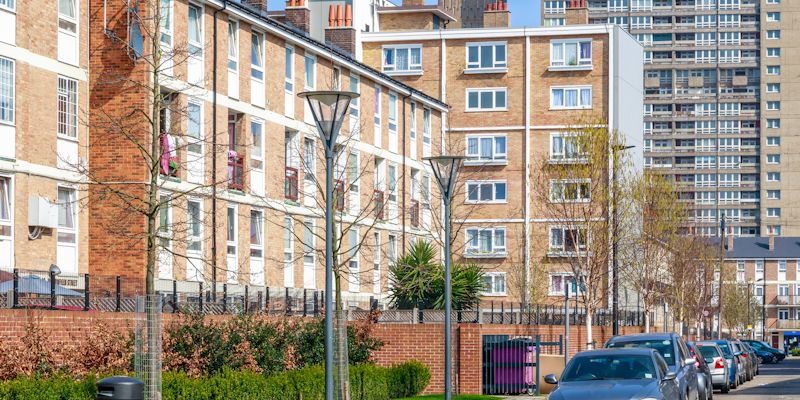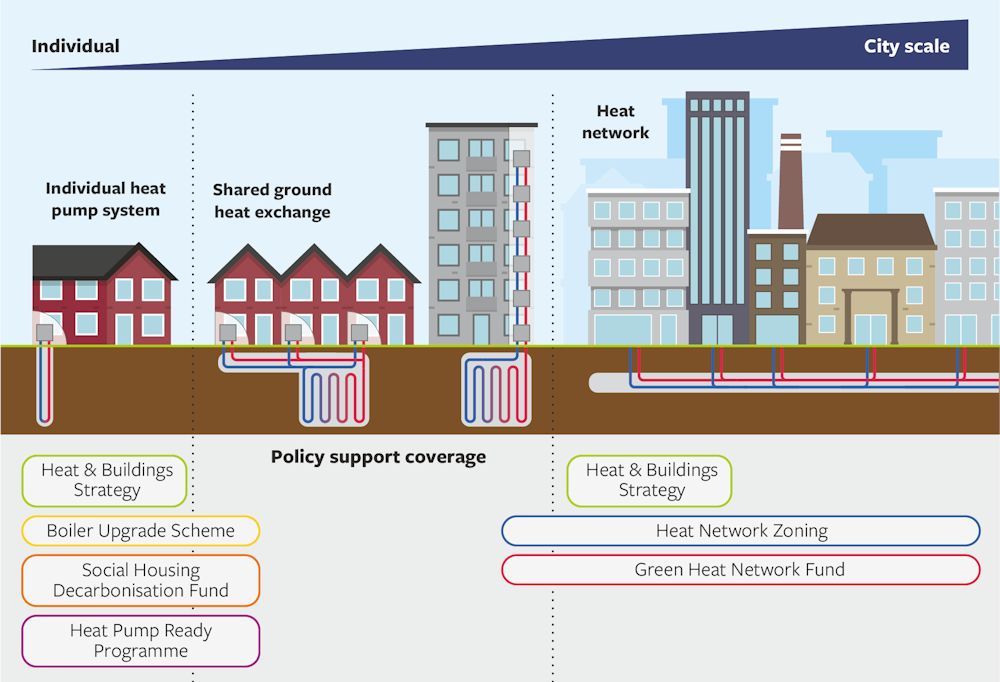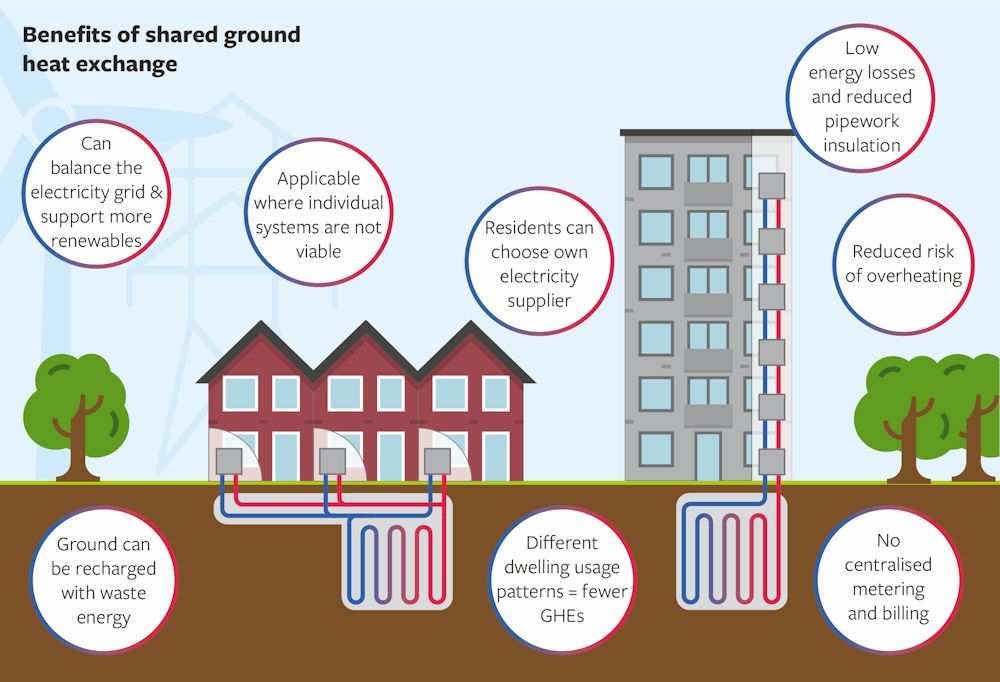Shared ground heat exchange for the decarbonisation of heat

Brief No.10, 6 April 2022. Catherine Bale, David Barns, Josh Turner.
Download or view the full policy brief: Shared ground heat exchange for the decarbonisation of heat.
Brief summary
Shared ground heat exchange can deliver low-carbon electrified heat where individual heat pumps or heat networks are not feasible, such as in terraced homes. However, there is a policy gap around these mid-scale heat solutions. We outline the benefits and challenges of shared ground heat exchange, and actions needed by policy, housing, and innovation stakeholders to support further deployment.
Overview
- Heat decarbonisation policies recognise the role of individual heat pump systems and heat networks but overlook the mid-scale where shared ground heat exchange could be applicable.
- Shared ground heat exchange may be ideal for medium-density settings such as terraced houses, housing blocks, and small neighbourhoods.
- Shared ground heat exchange offers significant potential for growth, innovation, and improved customer experience.
- Formal recognition of shared ground heat exchange in national and local policy is required to enable full deployment potential to be achieved.
Definitions
- Heat pump: appliance which uses electricity and energy taken from the environment (air, ground or water) to provide heating and hot water.
- Ground heat exchanger: pipes, typically in a borehole, which transfer heat to and from the ground.
- Shared ground array: multiple ground heat exchangers connected together for use by multiple dwellings.
- Shared ground heat exchange: distributed heat pumps in multiple dwellings connected to a shared ground array. They may be particularly suitable in medium-density areas.
- Heat network: central heat source connected to a range of users such as housing, commercial buildings, hospitals etc. Many configurations are possible.
Decarbonising heat
UK heat generation remains heavily reliant on fossil fuels. The energy used to heat buildings contributes about 23% of UK greenhouse gas emissions, and only 5% of UK heat demand is met by low-carbon sources. This must be addressed for the UK to meet its legally binding target of net-zero emissions by 2050.
Unlike decarbonising the electricity supply, where most changes take place far away from domestic dwellings, heat decarbonisation requires direct intervention in the 23m homes currently heated by a gas or oil boiler. The UK Government has set out its approach to addressing this challenge in the Heat & Buildings Strategy. This sets the ambition to increase deployment of heat pumps and heat networks and explore the potential of hydrogen for heating by 2026. However, there is a policy gap around mid-scale solutions like shared ground heat exchange, which could contribute to net zero.
Current policy landscape
We mapped current UK Government policies to explore the extent to which they recognised and supported shared ground heat exchange.

Here we examine these issues in more depth, looking at national and local approaches.
Heat and Buildings Strategy
The Heat and Buildings Strategy sets out the clear ambition for the UK to move away from fossil fuels for heating and cooling and to achieve net-zero by 2050, primarily through deployment of three key technologies: Heat pumps; heat networks; and hydrogen.
What this means for shared ground heat exchange: Because shared ground heat exchange systems combine distributed heat pumps with ambient heat distribution, they fall between the distinct policy areas of heat pumps and heat networks. They are potentially suitable for medium-density, semi-urban or rural areas, where individual heat pumps or heat networks may not be the best solution. However, because these are the areas of focus in the strategy, the potential benefits and particular challenges associated with greater deployment of shared ground heat exchange may not be recognised or addressed.
Heat network zoning
These are a key part of the Government’s strategy to increase heat network deployment. Following an initial consultation exercise, proposals are being developed to bring in Heat Network Zones across England by 2025 (policies implemented in Scotland in 2021).
What this means for shared ground heat exchange: Shared ground heat exchange is recognised as eligible for inclusion in zones when it can be connected to larger heat networks in zones. In practice, zoning proposals mean heat networks are likely to grow outwards from city centres with their large non-domestic heat demands. Shared ground heat exchange systems have the potential to meet the demand in areas outside of urban centres, and offer a favourable economic solution where heat demands are lower and a route to decarbonise dwellings not currently included in proposals.
Local planning policies
Having committed to achieving net zero emissions by 2030, many local authorities are updating their climate-related planning policies. This presents an opportunity to ensure shared ground heat exchange is recognised as a heating technology which can support decarbonisation in the right settings.
What this means for shared ground heat exchange: as a net-zero compliant solution based on efficient electrified heat provision, shared ground heat exchange should be recognised as an eligible heating option in planning policies. Support for developers to consider shared ground heat exchange can be provided through local authority recommendations and sharing of case studies.
Current funding situation
We identified several funding streams which could support social housing landlords, local authorities, and developers to invest in shared ground heat exchange. However, funding is primarily targeted at individual heat pump systems or large-scale heat networks, rather than the mid-scale shared ground heat exchange. Addressing the lack of support for shared ground heat exchange through funding streams which are aimed specifically at this market sector may help boost their deployment.
Benefits of shared ground heat exchange and challenges to deployment
The policy brief further explores the benefits and challenges associated with the deployment of shared ground heat exchange. Benefits included applicability for homes with no outside space, system efficiency and running costs, and reduced infrastructure requirements. Challenges included the maturity of the market with few suppliers and installers contributing to high capital costs, and the need for new business models which will enable deployment at scale.

Recommendations
Current policies tend to target individual heat pump systems or heat networks, with a gap identified around the mid-scale of shared ground heat exchange.
Based on the benefits, challenges and current policy landscape identified through the research, and through consultation with stakeholders, we propose some key recommendations:
National policy
- Recognition of shared ground heat exchange and its suitability for mid-scale, medium-density settings in national policy, including in the Heat Network Zoning proposals (BEIS).
Local implementation
- Recognise shared ground heat in local planning policies (local authorities).
- Identify where shared ground heat exchange may be the best solution for use in new developments (local authorities, housing developers).
- Ensure shared ground heat exchange is considered when developing heat network zoning plans (Local Zoning Coordinators).
Users
- Provide initial training and follow-on support to ensure users understand how to maintain comfort levels whilst operating the heating system efficiently and cost effectively (landlords, system developers, installers).
Business models
- More innovation and research into the creation of viable business models is required, including potential for utility business models and options for mixed-occupancy schemes (system developers, new market entrants, researchers, innovation agencies, BEIS).
Technical
- Development and provision of technical training for installers and suppliers (training providers, system developers, local authorities).
- Recognition and inclusion of shared ground heat exchange in standards for design, installation and operation. Compliance schemes to ensure standards are met (standards bodies e.g. CIBSE, MCS; regulator, e.g. Ofgem; other relevant bodies e.g. Heat Trust).
- Increased monitoring of installed system performance to better understand “diversity” benefit from connecting multiple households and reduce upfront costs (system developers, landlords).
About the authors
Catherine Bale is an Associate Professor in the School of Earth and Environment and School of Chemical & Process Engineering, University of Leeds.
David Barns is a Research Assistant in the School of Earth and Environment, University of Leeds.
Josh Turner is a Research Assistant and PhD Researcher in School of Civil Engineering, University of Leeds.
Further information
The shared ground heat exchange case studies, policy and funding mapping, Rapid Evidence Assessment data, and stakeholder workshop whiteboard can be accessed at: https://doi.org/10.5518/1137
To cite this policy brief, please reference: Bale, C, Barns, D., Turner, J. (2022) Shared ground heat exchange for the decarbonisation of heat. Brief 10, Policy Leeds, University of Leeds. https://doi.org/10.48785/100/91
Acknowledgements
The work also involved key contributions from Fleur Loveridge and Simon Rees at the University of Leeds and Martin Fletcher at Leeds Beckett University. Bill Kirkup and Denny Gray from CAG Consultants provided a vital external perspective.
We would like to thank project stakeholders for their participation and insights during the workshop which helped shape this work.